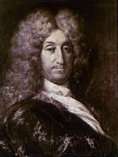William Craven, 1st Earl of Craven (1608–1697)
_by_Gerrit_van_Honthorst.jpg)
William Craven, 1st Earl of Craven, PC (June 1608 – 9 April 1697) was an English nobleman and soldier.
His father William Craven was born in a poor family in Appletreewick in North Yorkshire but moved to London, became wealthy, and was Lord Mayor of London in 1610. He married Elizabeth Whitmore, sister of George Whitmore, a later Lord Mayor of London. Their other children included John Craven, 1st Baron Craven of Ryton[1], Mary, who married Thomas Coventry, 2nd Baron Coventry and Elizabeth, who married Percy Herbert, 2nd Baron Powis.[2][3]
Craven fought for Frederick V on the Continent and fell in love with his wife, Elizabeth of Bohemia. Still being absent during the English Civil War, he supported this lady's brother, Charles I, financially rather than in person and, therefore, had all his lands – largely in Berkshire, but including his main country seat at Caversham Park in Oxfordshire – confiscated. After the Restoration, he set about planning to build a vast palace for Elizabeth at Hamstead Marshall in Berkshire with a hunting lodge at nearby Ashdown (now in Oxfordshire), but she died before construction began. Perhaps because of his devotion to Elizabeth, he never married.
After the Restoration, he was rewarded with several Court offices and given an earldom. He was granted a share in the Colony of Carolina and served as one of its Lord Proprietors. As a Privy Councillor he seems to have been diligent enough: Samuel Pepys in his Diary regularly mentions his attendance at the Committee for Tangier and his chairing of the Committee on Fisheries. In the latter role Pepys was rather shocked by his bawdy language which Pepys thought improper in a councillor (though perhaps natural in an old soldier). In 1678 we read of his presence at the historic Council meeting where Titus Oates first publicised the Popish Plot.
Pepys' attitude to Craven varies in the Diary- on the one hand he calls him a coxcomb and criticises his chairing of the Fisheries Committee; at other times he is glad that Craven is his "very good friend".
Whatever Pepys's opinion of him, Craven earned the lasting respect and gratitude of the people of London during the Great Plague of 1665 when unlike the great majority of noblemen, who fled to the country, he remained in London, helping to maintain order and donating property for burial grounds.
Craven County, North Carolina is named after William.

References
- Ford, David Nash (2001). Royal Berkshire History: William Craven, Earl of Craven (1608–1697)
- ↑ Shropshire Arch. Transactions 3rd Series Vol 11901 Manor of Ruyton XI Towns by Robert Lloyd Kenyon
- ↑ Lundy, Darryl. "Sir William Craven". thePeerage.com. Retrieved 20 August 2008.
- ↑ "History of Burnsall School". Archived from the original on 7 February 2006. Retrieved 20 August 2008.
Further reading
- Smuts, R. Malcolm (2004). "Craven, William, earl of Craven (bap. 1608, d. 1697)" (Online for subscribers, also available in print). Oxford Dictionary of National Biography. Oxford University Press. Retrieved 23 August 2008.
| Military offices | ||
|---|---|---|
| Preceded by The Duke of Albemarle |
Colonel of the Coldstream Regiment of Foot Guards 1670–1689 |
Succeeded by Thomas Tollemache |
| Honorary titles | ||
| Preceded by The Lord Lovelace |
Custos Rotulorum of Berkshire 1634–1689 |
Succeeded by The Duke of Norfok |
| Preceded by Sir Edward Nicholas |
Custos Rotulorum of Middlesex 1669–1689 |
Succeeded by The Earl of Clare |
| Preceded by The Duke of Albemarle |
Lord Lieutenant of Middlesex 1670–1689 | |
| Peerage of England | ||
| New creation | Earl of Craven 1664–1697 |
Extinct |
| Baron Craven 1626–1697 |
Succeeded by William Craven | |
